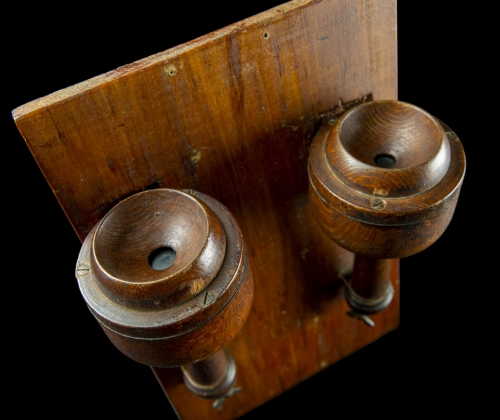
Self-taught Bay inventor made wooden telephones

In June 1927, an item that had been on public display in the window of William Cooper’s jewellery shop, Hastings Street, was presented to the Hawke’s Bay Museum. At that time the museum was located in the Athenaeum, on the corner of Browning and Herschell Streets.
The gift was a pair of wooden telephones built in 1876 by Thomas Hyde in Napier. Thomas, a self-taught man, was very interested in engineering, electrical and scientific inventions. In June 1876, the Scientific American magazine published an article about Alexander Graham Bell’s invention of the telephone. From this description, Thomas was able to design and construct a pair of telephones and transmitter.
The phones were built out of honey-suckle, with cast steel magnets and binding screws taken from an old tambourine. The transmitter, a separate item from the phones (and not gifted), was considerably altered by substituting carbon for the magnet - which the American inventor, Thomas Edison, found gave better results in pulsating electric currents.
Two houses directly across from each other in Carlyle Street, Napier, were used to trial the telephone – the electrical connection was a success. Thomas then accomplished single-line connections between Napier and Wairoa, Napier and Waipawa, Waipawa and Waipukurau, and as far afield as Woodville and Palmerston North.
Who was this talented man? Thomas Hyde was born, 7 June 1848, on the family farm at Buckden, Huntingdonshire, England. Like many children of the period, he did not attend school - instead he was required to support the family income by working on the farm. At the age of 16 he was apprenticed to a coach-building firm, where he learnt the engineering and mechanical skills which stood him in good stead throughout the remainder of his life.
Ever adventurous, Thomas immigrated to Christchurch, New Zealand in 1868, on board the Gainsborough. In 1869, while living in Christchurch, he designed the first small-wheeled bicycle in New Zealand and successfully won competitive races riding it.
Four years later, he moved to Napier, working for George Faulkner and then buying into a partnership with Shanley & Co – both coachbuilding businesses. When Edison, in December 1877, developed the phonograph, a machine used for recording sound, Thomas very quickly replicated the machine using tin-coated cylinders with two needles, one for recording sound and the other for playback. The interest was such that the phonograph was exhibited in the back room of a Napier shop for the public to see and hear.
Keen to study music, Thomas taught himself the organ and became chief organist for the congregation of his local Napier church. He also studied photography, and from his photographs made lanternslides (an early form of slideshow) and gave public lectures on the image subjects in various towns and villages throughout Hawke’s Bay.
In 1878, being a member of the Woodville Special Settlement Association, he purchased a bush property in the Victoria block, near the township. Here he established a home for himself, wife and family. Thomas was reputed to have the most up-to-date farm in the Woodville district. With his mechanical and engineering knowledge, he was able to make all the machinery required for running the farm.
Thomas also constructed a private networked telephone system for the district, connecting his neighbours and several businesses, one being the Post Office. In 1905 Thomas sold his farm, purchased a property in Main Street, Napier and among other things built houses. He died 3 June 1930, aged 82 years. The Hawke’s Bay Herald recorded that “he was held in the highest esteem by all who knew him”.
WHAT’S ON –
- Floral Embroidery Workshop with tutor Fleur Woods. Saturday 21 and Sunday 22 September 10.30am-4pm, SOLD OUT.
- NZIA Aon Gold Medal Lecture Series – Jeremy Salmond. Tuesday 24 September, 6pm, MTG Century Theatre. Free event, please register through Eventbrite.
- Meet the Artist – Mauricio Benega. Sunday 29 September, 4pm, MTG Century Theatre. Free event, koha appreciated. Please register through Eventfinda.
- School Holiday Programme – Create your own virtual tour (8+ years). Wednesday 2 October 10am-12pm. Tickets available through Eventfinda.
- School Holiday Programme – Geometric Art (7-12 years). Thursday 3 October 10-11.30am. Tickets available through Eventfinda.
- Technique Tasters with tutor Jo Dixey, learn different stitch techniques including crewelwork, goldwork, and blackwork. Saturday 5 and Sunday 6 October 10am-12pm and 2-4pm. Tickets available through Eventfinda.
Image is of the wooden telephones built by Thomas Hyde in 1876
22 September 2019



